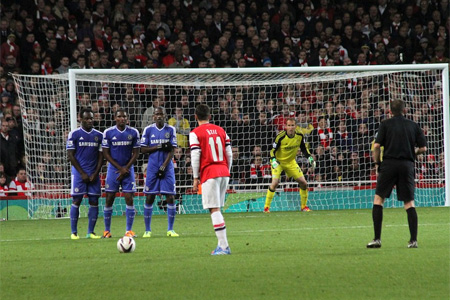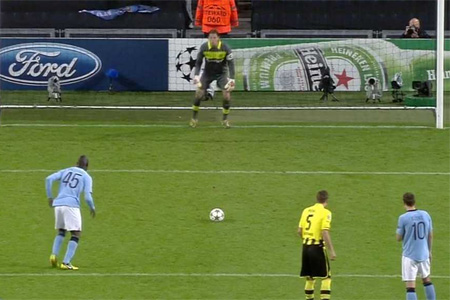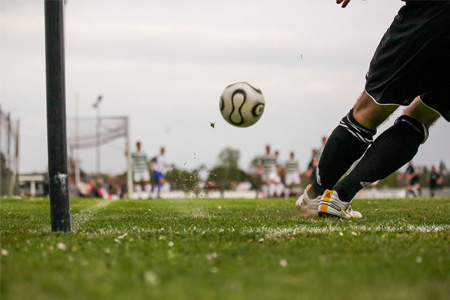|
|

|
|


Free-kicks shall be classified under two headings. Direct (from which a goal can be scored direct against the offending side) and Indirect (from which a goal cannot be scored unless the ball has been played or touched by a player other than the kicker before passing through the goal).
When a player is taking a direct or an indirect free kick inside his own penalty area, all the opposing players are at least 10 yards from the ball and remain outside the penalty area until the ball has been kicked out of the area. The ball will be in play immediately it has traveled the distance of its own circumference and is beyond the penalty area. The goal keeper will not receive the ball into his hands, in order that he may thereafter kick it into play. If the ball is not kicked direct into play, beyond the penalty area, the kick is retaken.
When a player is taking a direct or an indirect free kick outside his own penalty area, all of the opposing players are at least 10 yards from the ball, until it is in play, unless they are standing on their own goal line between the goal post. The ball will be in play when it has traveled the distance of its own circumference.
If a player of the opposing side encroaches into the penalty area or within 10 yards of the ball before a free kick is taken, the referee may delay the taking of the kick, until the law is complied with.
The ball must be stationary when a free kick is taken and the kicker will not play the ball a second time until it has been touched or played by another player.
Notwithstanding any other reference in these laws to the point from which a free kick is to be taken.
Any free kick awarded to the defending team, within its own goal area may be taken from any point within that half of the goal area in which the free kick has been awarded.
Any indirect free kick awarded to the attacking team within its opponents goal area was taken from that part of the goal area line which runs parallel to the goal line, at the point nearest to where the offence was committed.

A penalty kick is taken from the penalty mark and when it is being taken, all players with the exception of the player taking the kick, properly identified, and the opposing goal keeper, is within the field of play but outside the penalty area, and at least 10 yards from the penalty mark. The opposing goal keeper must stand (without moving his feet) on his own goal line, between the goal posts, until the ball is kicked. The player taking the kick must kick the ball forward. He will not play the ball a second time until it has been toughed or played by another player. A goal may be scored directly from a penalty kick. When a penalty kick is being taken during the normal course of play or when time has been extended to half time or full time to allow a penalty kick to be taken or retaken, a goal will not be nullifies if, before passing between the posts and under the cross bar, the ball touches either or both of the goal posts or the cross bar or the goal keeper or any combinations of these agencies, providing that no other infringement has occurred.

When the whole of the ball passes over a touch line, either on the ground or in the air, it is thrown in from the point where it crossed the line, in any direction, by a player of the team opposite to that of the player who last touched it. The thrower at the moment of delivering the ball must face the field of play and part of each foot shall be either on the touchline or on the ground outside the touch line. The thrower uses both hands and deliver the ball from behind and over his head. The ball is in play immediately, it enters the field of play, but the thrower will not play the ball again until it has been touched or played by another player. A goal will not be scored direct from a throw in.
When the ball passes over the goal line, excluding that portion between the goal posts, either in the air or on the ground, having last been played by one of the attacking team, it is kicked direct into play beyond the penalty area from a point within that half of the goal area nearest to where it crossed the line, by a player of the defending team. A goal keeper will not receive the ball into his hands from a goal kick in order that he may thereafter kick it into play. If the ball is not kicked beyond the penalty area i.e. direct into play, the kick is retaken. The kicker will not play the ball a second time until it has touched or been played by another player. A goal is not scored direct from such a kick. Players of the team opposing that of the player taking the goal kick remains outside the penalty area until the ball has been kicked out of the penalty area.

When the whole of the ball passes over the goal line, excluding that portion between the goal posts, either in the air or on the ground, having last been played by one of the defending team, a member of the attacking team shall take a corner kick, i.e. the ball is placed within the quarter circle at the nearest corner flag post, which must not be moved and it must be kicked from that position. A goal may be scored direct from such a kick. Players of the team opposing that of the player taking the corner kick will not approach within 10 yards of the ball until it is in play nor the kicker play the ball a second time until it has been touched or played by another player.
A player is in an off side position if he is nearer to his opponents goal line than the ball, unless there are at least two of his opponents nearer their own goal line than he is. A player is only declared off side and penalized for being in an off side position.
If a player is declared off side, the referee awards an indirect free kick, which is taken by a player of the opposing team from the place where the infringement occurred.
|
|